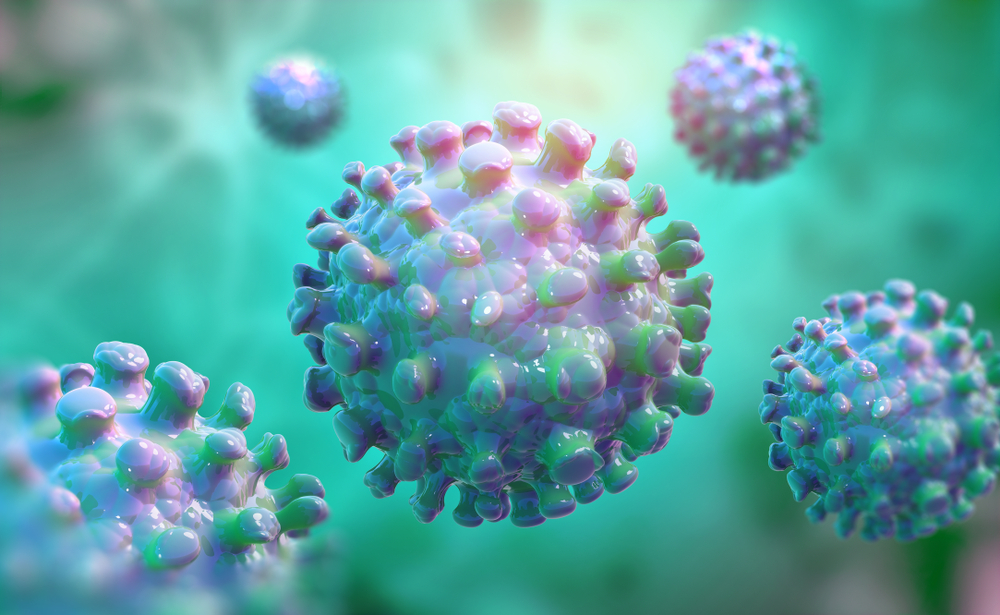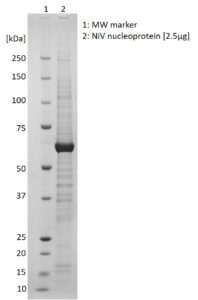SDS-PAGE: Coomassie-stained SDS-PAGE showing purified Nipah virus Nucleoprotein.
Nipah Virus Nucleoprotein (N), His-tag
Price range: $674.76 through $2,526.66 excl. VAT
This product is a recombinant Nipah virus Nucleoprotein (N), expressed and purified from mammalian cells with Manufactured for vaccine research and development of ELISA and rapid test immunoassays.
NIPAH VIRUS NUCLEOPROTEIN (N), HIS-TAG
Nipah virus Nucleoprotein (N) is a recombinant protein expressed and purified from mammalian cells.
PRODUCT DETAILS – NIPAH VIRUS NUCLEOPROTEIN (N), HIS-TAG
- Nipah virus Nucleoprotein (NCBI accession number NP_112021.1, AA1-532), expressed and purified from HEK293 cells.
- The protein contains a C-terminal glycine-serine linker, a TEV protease site and a His-tag.
- Presented in 50mM HEPES pH8.0, 150mM NaCl, 4M urea, sterile filtered.
- For use in vaccine R&D and immunoassay development.
BACKGROUND
Nipah virus (NiV) is an emerging and highly pathogenic zoonotic paramyxovirus (genus Henipavirus) that is transmitted by its natural reservoir, Pteropid bats. NiV initially emerged in 1998 in Malaysia, and is now distributed in Asia, Africa, and the South Pacific Ocean. It causes deadly respiratory and encephalic diseases in humans. Because its mortality rate can exceed 70% in humans, its potential for human-to-human transmission and the absence of vaccine or specific antiviral treatment, it is classified as a biosafety level 4 (BSL-4) pathogen (Yabukarski et al., 2014).
The NiV genome consists of a negative-sense, single-stranded RNA of approximately 18.2 kb, encoding six structural proteins, nucleoprotein (N), phosphoprotein (P), matrix protein (M), fusion protein (F), attachment glycoprotein (G), and the large protein or RNA polymerase protein (L). In addition, the P gene encodes three non-structural proteins by RNA editing (V and W proteins) or an alternative open reading frame (C protein) (Wang et al. 2001).
NiV genomic RNA is condensed by a homopolymer of nucleoprotein (N), forming long helical nucleocapsids (NCs). The nucleoprotein encapsidates the genome protecting it from nucleases. Ribonucleoprotein complexes (RNP) are then used as a template for RNA synthesis by the viral RNA-dependent RNA polymerase (Yabukarski et al., 2014). Within the RNP, N is responsible for viral genome wrapping and facilitates viral replication and transcription (Lee et al., 2012).
In February 2018, Nipah Virus (NiV) infection was listed as a priority disease posing a public health risk by the World Health Organization (Sun et al., 2018).
REFERENCES
- Lee et al. (2012). Henipavirus: ecology, molecular virology, and pathogenesis. Curr Top Microbiol Immunol 359:V–VI.
- Sun et al. (2018). Phylogeography, Transmission, and Viral Proteins of Nipah Virus. Virologica Sinica. Volume 33, Issue 5, pp 385–393.
- Wang et al. (2001). Molecular biology of Hendra and Nipah viruses. Microbes Infect 3:279–287.
- Yabukarski et al. (2014). Structure of Nipah virus unassembled nucleoprotein in complex with its viral chaperone. Nature Structural & Molecular Biology. Vol 21 No. 9.


